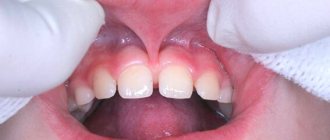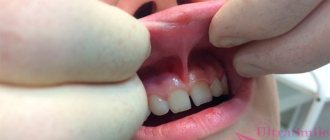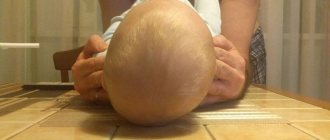If your child speaks poorly or you notice obvious signs of malocclusion in your baby, you should go for a consultation with a pediatric dentist. You can get rid of these and other problems with a simple procedure - you need to correct a short frenulum of the tongue in a child.
The frenulum of the tongue is a bridge that connects the tongue and the lower palate. It is responsible for how the tongue functions, affects speech, the ability to drink and eat, and swallow. The condition of the frenulum even affects the breathing process!
Here there is the possibility of pathology consisting in insufficient length, which leads to the recommendation to trim the frenulum of the child’s tongue. Why is it needed?
Let's consider the reasons for the need for this operation for children from a very early age. For newborn babies, sucking is a vital function. It is she who suffers in case of frenulum pathology. If it is not trimmed, the baby will not be able to drink mother's milk, including from a bottle with a nipple. It must be said that surgery in early childhood is easier to tolerate than in adulthood, so parents should not worry about the baby’s well-being.
Further, if a short frenulum of the tongue is detected at an older age, doctors advise surgery to prevent the defect from affecting the formation of the bite, and to avoid speech problems and disturbances in the process of eating.
Tongue frenulum cutting - what is it?
Plastic surgery of the lingual frenulum can be performed at different ages, but it is mainly performed on newborn children, since disruption of the formation of the mucosal fold under the tongue causes a number of functional disorders.
The procedure for trimming the frenulum of the tongue is a low-traumatic surgical procedure performed by a dentist. The frenulum of the tongue is a fold of the oral mucosa that stretches in the shape of an arc from the central point of the tongue to the middle of the lower dentition at the base of the gums. The main function of the frenulum is to attach the tongue to the lower part of the mouth.
If there are deviations in the location or length of the fold, the movement of the tongue will be impaired, resulting in incomplete functionality. The purpose of the operation is to increase the length or correct the position of the frenulum.
Postoperative period
The mucous membrane in the mouth is restored quickly. But cutting the frenulum can cause complications:
- Formation of a hard scar at the site where the incision was made.
- The development of the inflammatory process due to infection.
- Temperature increase. It appears as a sign of the development of an infectious process or a peculiar reaction to an operation.
The baby may react to complications with constant anxiety and refusal to eat. Children three years old and older can tell themselves what worries them. If you experience any discomfort, you should consult a doctor; only a specialist will correctly assess the baby’s condition and prescribe the best treatment.
To avoid complications, you need to keep your mouth clean. Five-year-old children already brush their teeth and can rinse their mouths with water. For several days after the defect is removed, you should not chew solid food or talk much.
You should ask your doctor exactly how long the restrictions should be observed. After a follow-up examination, the attending doctor will recommend special exercises to develop the elasticity of the frenulum.
Indications for the procedure
For newborn children, cutting the frenulum of the tongue is recommended quite often. A pediatrician or dentist can identify the pathology. In most cases, disorders are detected already in the first months of a child’s life. At the same time, the doctor always takes into account the individual characteristics of the structure and position of the mucous fold.
If we are talking about a newborn baby, then plastic surgery is prescribed in the case of obvious pathology in the formation of the frenulum, or difficulties with breastfeeding. The baby may have difficulty latching on to the nipple or pacifier and difficulty sucking on the breast or bottle.
Untimely plastic surgery may subsequently lead to difficulties with chewing food, bite formation, and diction problems. In older age, recommendations for surgical treatment can be given by a speech therapist or orthodontist.
The essence of the problem
Photo: this is what a normal frenulum looks like in a child’s mouth
The tongue is attached to the base of the mouth by its root part. Between the tongue and the lower edge of the mouth there is a small fold of skin - the frenulum. Normally, it should be such a length that a person can easily move his tongue, stick it slightly beyond the lips, touch the front surface of the teeth, and pronounce sounds.
A shortened frenulum of the tongue greatly limits its mobility, speech capabilities and ability to eat normally.
, especially in children. The same problems arise if it is not attached correctly, when it is in close proximity to the tip of the tongue.
The consequences are:
- Photo: this is what an incorrectly positioned frenulum looks like
During the period of breastfeeding, the baby is unable to suckle normally, as the tongue is limited in its movements. Because of this, children become very anxious, cry, and lose weight.
- Lack of nutrition can have a negative impact on any developing system of the body, causing stomach diseases.
- A child with a short frenulum develops an incorrect bite, which causes dental diseases and their displacement.
- After teething, when trying to stick out the tip of the tongue, the baby will injure it on the lower incisors.
- In older children, a short hyoid frenulum complicates the formation of sounds: it is difficult for them to pronounce words, and the process of learning speech is delayed.
- The breathing mechanism changes: the baby gets used to breathing through the mouth. Symptoms of the pathology
The frenulum in newborns normally has a length of about 8 mm
or more, and for five-year-old children it increases to 17. But mothers are not always able to take measurements at home, especially if the baby is very active. And only specialists can understand whether everything is located correctly in the oral cavity.
You can determine whether a child has a short frenulum by some external signs:
- In infants, due to their low ability to suck milk, loud smacking and clicking sounds appear.
- The baby attaches incorrectly to the breast, does not cover the areola with his mouth, so he often bites the nipple, which then becomes inflamed.
- The baby is nervous, arches, twists his arms and legs when feeding, often throws and applies to the breast again. Does not gain weight or even lose it.
- The tip of the tongue may be bifurcated due to shortening of the septum. What a child’s forked tongue looks like with a short frenulum, look at the photo on the right.
- Older children have noticeable speech defects, their voice is nasal and quiet.
- Saliva production increases.
- Apnea attacks are possible.
- Due to insufficient food processing, digestive problems occur.
If parents suspect a problem, they should contact their pediatrician or dentist. But in many cases, the defect is determined by a neonatologist in the maternity hospital.
Contraindications
Tongue frenuloplasty in newborns does not involve major surgical intervention, so the operation is considered safe. In addition, the procedure is painless and does not require anesthesia. However, given that after cutting a short fold of mucosa, a small wound still forms, there are temporary restrictions on manipulation related to the child’s health condition.
Temporary contraindications:
- inflammatory diseases;
- infectious diseases;
- immunodeficiency pathologies;
- acute respiratory viral or bacterial infections.
If there are contraindications for health reasons, it is advisable to postpone the operation until complete recovery.
Who to contact for help
Depending on the complexity of the situation, an orthodontist or speech therapist will help you cope with the problem. In any case, it makes sense to first get a consultation to decide what method of correction the child needs.
The dentist will carefully trim the frenulum, relieving the child of discomfort with one movement of his hand. However, recently doctors still recommend leaving surgical intervention as a last resort. An experienced speech therapist will offer a set of exercises and massage to stretch the frenulum.
Experts say that there are not many situations when the hyoid frenulum is absolutely unable to stretch. In almost all cases, a conservative approach achieves results.
Parents can evaluate the pros and cons of different approaches on their own.
Surgical method:
- A quick, radical solution to the problem.
- The operation is performed using anesthesia.
- The healing process takes some time and is uncomfortable.
- Dietary restrictions due to surgery.
- It is advisable to maintain vocal rest for several days.
- Psychological trauma in the child is possible.
- After the operation, classes with a speech therapist are necessary to correct sound pronunciation.
Frenum stretching method:
- Conservative, does not cause psychological difficulties in the child.
- Effective in most cases.
- Does not require changes to your usual routine.
- It takes some time (several months).
- Requires discipline and regular practice.
In any case, to resolve the issue, you need to consult a speech therapist.
Features of the procedure
Plastic surgery of the frenulum of the tongue involves cutting it with a scalpel or surgical scissors. After cutting the fold of the mucous membrane in a newborn, the tissue immediately stretches and lengthens after healing. When the operation is performed at the age of 3–5 years, the process of stretching the frenulum is more complex. To increase the length of the fold and prevent the formation of scars, the child will need to perform special exercises.
In Martinka dentistry, plastic surgery of the frenulum of the tongue and lip is performed not only by the classical, but also by the modern method using a laser. The use of laser equipment eliminates the risk of infection and bleeding. The laser has an antiseptic effect and instantly seals the vessels; moreover, during the operation there is no contact of the instrument with the tissues of the oral cavity. Laser surgery involves contraindications and is only allowed for children over 1 year of age.
For newborn children, tongue frenuloplasty can be performed without anesthesia. In children from 3 months of age, the folds of the mucous membrane thicken, which suggests discomfort and minor pain during the operation, so cutting the frenulum is done with local anesthesia. Sedation is used only in extreme cases, if the child has complex illnesses or increased anxiety.
At what age should this be done?
If we talk about a non-surgical method for stretching the hyoid ligament, it is effective up to the age of 5 years with constant and regular training.
The operation as a whole has no restrictions and no special recommendations about at what age it should be done. Each stage of development of a child’s body requires one of several ways to correct this ligament. Thus, newborns undergo a dissection of the frenulum, and already at the age of 2–3 years, when the tissue of the ligament becomes denser, the need for sutures arises. Sometimes it may be necessary to remove some of the ligament tissue. Laser surgery has no age restrictions.
To avoid the formation of malocclusion and displacement of the dentition, it is advisable to correct the frenulum before the molars appear.
Stages of the procedure
Trimming a short frenulum, despite the lack of complexity of the procedure, should be performed by a qualified specialist and in a medical facility. Patients do not require hospitalization. The operation takes no more than 10 minutes. Immediately after completion of the plastic surgery, the child is sent home. It is not recommended to feed the baby in the first two hours. Young children are allowed to drink water.
Stages of plastic surgery of the frenulum of the tongue.
- Preparation. The doctor asks parents for complaints, performs an examination and, if necessary, gives recommendations on preparation for the procedure.
- Operation. Administration of anesthesia, antiseptic treatment of the oral cavity, trimming of the frenulum.
In newborns, the integrity of the mucous membrane is restored in 1–3 days. The child may be restless on the first day. Difficulties with feeding cannot be ruled out, but already on the second day, babies begin to correctly take the breast or bottle nipple, which caused difficulties previously. Parents are advised to give the baby water after each feeding to avoid the accumulation of formula or milk in the mouth and the subsequent development of infection. Also, the mother must maintain breast hygiene and sterilize bottles.
Rules for rehabilitation after frenuloplasty
Many parents are interested in whether it is dangerous to have frenuloplasty. There can be only one answer here - it’s more dangerous not to do it at all. The procedure is very simple to perform, and there are almost never any complications after it. But, of course, as after any other operation, you need to follow some recommendations:
- limit consumption of hot and cold foods,
- Carry out oral hygiene with extreme caution,
- follow the doctor’s orders and do language exercises to restore speech after the procedure,
- visit a speech therapist to learn how to speak correctly.
These simple recommendations will help maintain health and very quickly return your child to a full life. But parents will definitely be required to monitor compliance with the rules.
1 Kozlova S.I. Hereditary syndromes and medical genetic counseling. Atlas-reference book, 1996.
results
The main goal of tongue frenuloplasty is to prevent tongue dysfunction that occurs subsequently. If you do not trim the folds of mucous membrane, then in the future the child may have difficulties with eating, diction and lip movements.
Don't be afraid of surgery. This is a simple procedure that takes a few minutes, and the cutting of the short frenulum itself takes place in a few seconds. Since the mucous membrane in children is still too thin, the child does not feel pain. Minor bleeding goes away quickly and does not pose any danger.
The help of a qualified dentist is an absolute guarantee of high-quality results and the absence of complications.
Torn frenulum
In some children, an unfortunate fall causes a rupture of the frenulum of the tongue. This injury can occur due to close contact of the septum with the lower teeth.
. If a child cuts the frenulum, he may experience bleeding and swelling in the oral cavity, and it becomes painful for the baby to chew and talk.
You cannot rely on self-medication; you should immediately consult a doctor. Sometimes it is necessary to stitch up the resulting wound due to the risk of excessive bleeding.
The importance of such a part of the body as the frenulum cannot be underestimated. There are many ways to lengthen the small septum to free up the tongue for free speech and eating. Before taking certain measures, it is necessary to consult with a specialist and do preoperative tests if it is necessary to trim the frenulum.
If the anomaly causes organ dysfunction, then frenuloplasty is necessary, and it is best to perform it at the age recommended by the doctor. Ignoring such a problem means exposing the child to the risk of frequent respiratory and digestive diseases, and problems in pronunciation of sounds.
Short frenulum: to treat or not to treat?
Hello dear audience, today I, urologist-andrologist Gennady Valentinovich Volovich, would like to consider such a problem as a short frenulum.
Many male representatives believe that this is not a problem at all, many do not notice it in themselves, many believe that it does not need to be treated.
However, relying on my experience and the opinion of my colleagues, I must tell you that a short frenulum can cause many problems
What is a short bridle?
A short frenulum of the penis is a congenital anomaly, manifested in insufficient length of the skin cord between the foreskin and the head of the penis.
Normally, the head of the penis deviates downward relative to the main axis of the shaft of the penis from 0 to 30 degrees. Over 30 degrees is already excessive, and readings of 25-30 degrees can also cause problems under certain circumstances. That is, from 20 to 30 degrees is a relative norm.
Most often, this pathology is detected during the first sexual intercourse, since during an erection the shortened frenulum is subject to excessive tension and rupture. In this case, the injury may be accompanied by severe pain and profuse bleeding, which can lead to significant blood loss, since a large artery passes through the thickness of the frenulum. In less severe forms of this disease, a man may experience:
- strong tension of the frenulum in the erect state of the penis and the development of pain (including during sexual intercourse);
- insufficient filling of the cavities of the cavernous bodies with blood and, as a result, insufficient increase in the volume of the penis and its hardening;
- strong curvature of the penis towards the scrotum, making sexual intercourse very difficult (or even completely inaccessible);
- development of sexual dysfunction, in which ejaculation occurs too quickly; damage to the frenulum during sexual intercourse in the form of cracks and tears with bleeding, which can be very profuse. Bleeding occurs at the most inopportune moment and you have to urgently look for a hospital with improvised bandages
- Due to the incorrect excessive bending of the head of the penis downwards during sexual intercourse, the partner may experience excessive friction in the area of the lower wall of the vagina, vaginal dysbacteriosis occurs, the girl-woman undergoes expensive smears, is treated, but all in vain, since the field of sexual intercourse arises again dysbiosis.
If left untreated, due to frequent tears, the frenulum can turn into a painful scar cord. This entails increased sensitivity of the glans penis, which, in turn, can provoke premature ejaculation. And as a consequence of this, one’s own dissatisfaction and that of one’s partner.
And here's the result:
The development of complications can only be prevented by surgery, and the earlier treatment is started, the fewer old tears in the frenulum, the easier this problem is to correct and the better the postoperative result. The only way to treat this pathology is plastic surgery to lengthen the frenulum - frenuloplasty. It is performed on an outpatient basis under local anesthesia and lasts about twenty minutes. The essence of this surgical intervention is to dissect the short frenulum of the penis in the transverse direction. In some cases, up to three incisions may be required.
The patient can return home on the same day. Wound healing continues for 8-14 days.
In our center, any version of frenuloplasty is performed: using a scalpel, radio knife or laser.
Take care of your health and the health of your partner, check with a urologist for the presence of this pathology, and if there is a problem, have a frenuloplasty.










